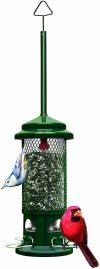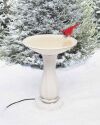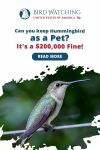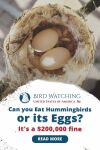
What’s This Post About?
The Blue Jay is a big songbird with a remarkable mixture of blue, white, and black plumage and a mottled pattern following its tail and feathers, and a short-pointed beak.
These birds may be found in various habitats and are regular visitors to parks in suburban and residential areas.
In a three-ounce package, Blue Jays are a splendid combination of beauty, brains, and energy, and it wouldn’t come as a surprise if you wanted to keep one of these as a pet.
But unfortunately, that’s not doable since strict laws protect these birds.
You cannot keep blue jays as a pet; it is illegal in the United States to keep any native wild bird as a pet, including Blue Jays. They are legally protected under federal law courtesy of the Migratory Bird Treaty Act of 1918. Only qualified rehabilitators are permitted to keep wild birds.

Where Do You Find Blue Jays?
Blue Jays are forest dwellers by nature, also found in residential parks throughout the eastern and central United States.
They are also adaptable and clever birds. They can also be found in parks and suburbs because they are regular visitors to backyard bird feeders.
If you’re living in the Eastern and Central regions of the United States, you can easily spot a Blue Jay in your neighborhood.
They’re extremely territorial; this trait of theirs compels them to become permanent residents of the areas they inhabit throughout the year.
Fun Fact
According to the North American Breeding Bird Survey, 87% of blue jays live in the U.S, and the rest, 13%, live in Canada.
Can You Tame Blue Jays?

You can tame Blue Jays; however, it depends on how you go about doing so.
For example, if you’re raising one in your backyard from the time it is a nestling/fledgling, then you have a good chance of taming one.
But if you’re trying to tame a grown Blue Jay, then you should give it another thought because it’s comparatively difficult to tame a bird that’s grown.
For Blue Jays to not be frightened of humans, they must grow up around human presence.
So, if you have a bird feeder in your backyard and Blue Jays feed on it, make sure you frequent it often as this may desensitize them to your presence and later help.
Can Blue Jays Live in Captivity?
Living in captivity is something blue jays cannot associate with since they are primarily categorized as wild birds.
They require open spaces and other resources such as food items and tree branches to survive in the wild.
Their behavior might differ depending on how they’re kept, which wouldn’t be possible since it’s illegal to keep them as pets.
Fun Fact
Blue Jays have considerably longer lived in captivity, with the oldest blue jay documented reaching the age of 26. They live in the wild for 5-7 years, that too rarely.
Blue jays are not quiet birds. If you hold on to them, they will learn to imitate your speech and other similar sounds around them, including cat sounds.
More so, blue jays held captive have been noticed to make use of paper strips to take in food while, on the contrary, wild blue jays would never be seen doing such acts.

Why Is It Illegal to Keep Blue Jay As A Pet?
In the early 1900s, United States saw a troubling extinction of several wild birds as they were constantly hunted and killed for their feathers.
The Migratory Bird Treaty Act made it illegal to own or sell birds, including their feathers, as the fashion industry mainly used them for hats and other accessories.
So, even if you come across a feather lying around, you should not take it home, as doing so is illegal. You can’t even be in possession of a fallen feather since the law protects it.
The law, rightfully, prohibits keeping any native wild bird as a pet or to capture, kill, or hurt them, and this includes all species of jays in the United States.
Regardless of how uncommon or numerous they are, they are protected by federal law (the Migratory Bird Treaty Act of 1918).

Besides federal laws, one cannot hold onto a wild bird as it would be an irresponsible act. Blue jays are wild birds which means they deserve to live in their natural habitat, i.e., the wild.
Confining or capturing a jay would be unethical, regardless, even if you find a jay on the ground and mistake it to be orphaned.
If such is the case ever, contact your nearest wildlife conservation agency and hand over the bird to them.
Who Do Blue Jays Attack?
Many Blue Jays have been seen targeting other birds, taking their food, and even devouring their victims’ younglings.
While they seem to be troublemakers that push others away and selfishly eat all the food they can get their hands on, blue jays are not aggressive against their own kind.

Blue Jays may fiercely protect their food and breeding territories; they do not hesitate to fight other birds invading their personal space.
They’ve also been seen leaping at dogs, cats, and people who get too close. Blue jays are particularly aggressive during their nesting season. Any bird or creature can fall victim to their aggression.
How Can You Attract Blue Jays To Your Yard?
If you want these stunning birds to visit your backyard, you must provide them with essential food and water sources along with nesting trees/sites to make them feel welcome in your yard, where they can make a home for themselves.
1. Food Source
This is one way to win Blue Jays over as they, just like any other bird, enjoy a broad range of treats.
You can offer them nuts, peanuts, suet, worms, corn, and sunflower seeds which are some great options to attract them.
You could also consider providing them with natural food sources, including berries and small fruit.
PRO-TIP
Do not hang feeders that may sway or wobble; it’ll frighten these large birds. Instead, you can invest in a pole-mounted feeder since it’s more stable!
Since Jays are particularly large songbirds, wide tray or platform feeders are excellent for providing various meals throughout the day, and mesh or spring feeders are great for providing nuts.
Explore the Squirrel-proof Bird Feeder to attract blue jays to your backyard.
Squirrel Buster Standard Squirrel-proof Bird Feeder
The weight of an adult squirrel automatically closes the shroud denying access to seed.
2. Trees and Shrubs
Several trees are widely loved by Blue Jays, including Oak, hickory, and beech trees. These trees provide an abundant source of nuts as well as thick branches for blue jays to perch on and nest in
Shrubs are also an integral part of their day-to-day lives, including American Basswood, crabapple, Eastern Hemlock, Eastern White Pine (for nesting as well), red mulberry, sumac, and wild cherry.
These shrubs are a great investment if you’re looking to attract blue jays to your yard, as they provide fruits and nuts in ample amounts to these hungry little songbirds all year round.

3. Water Source
Blue Jays need to drink water and accommodate these magnificent birds; you must consider installing a broad and deep birdbath.
They need a deep birdbath because it’s used for moving, splashing, or dripping water, which can pique their interest with splashing noises and reflecting droplets.
Blue Jays families like to visit the backyard together; larger baths help accommodate numerous birds simultaneously.
Since these birds stay in their ranges all year, a heated birdbath is needed throughout the winter season, even in northern places.
Consider exploring the API Heated Birdbath.
API Heated Birdbath Heated Bird Bath with Stand
This heated bird bath keeps water ice-free all winter thanks to its fully enclosed heating element.
4. Shelter
Birds want safe, secure places to nest in, and old coniferous and deciduous trees are excellent for providing a haven for jays.
If you want to encourage jays to hang in your backyard, you must plant trees that can double as food sources.
The tree mentioned above types are excellent choices, and shrubbery will give delicious cover as well.
Copse-like vegetation will make jays feel more comfortable, especially if there is a food source or water supply for the birds to enjoy in the sheltered nook.
5. Nesting Site
Jays do not use birdhouses since they do not like to nest in hollow spaces and chambers, but the same trees that provide adequate protection can also provide suitable nesting spots.
Providing proper nesting material, such as tiny twigs, sticks, and grass cuttings, can motivate jays to nest, and they may take full advantage of wide, accessible nesting sites.
Ideally, the site platform should be at least 8 to 10 inches square to facilitate the large nests and growing hatchlings of these birds.
Pro-Tip
Leave a considerable amount of leaf litter for birds to use for foraging and camouflage their feed seeds and leave these catches so that they can visit later and still find their food stored away.

Keep Reading!
To encapsulate the entire discussion, Blue Jays are the most entertaining birds to have in your backyard.
However, keeping them as pets would hinder their naturally occurring comical side; therefore, it is advised that they’re left alone to roam about freely.
Taking a wild creature from its natural habitat and keeping it in a cage is not an ethical practice, so the law makes it illegal to own Blue Jays.
Bird watchers who fully comprehend the behavior and needs of jays can enjoy them all year without inconveniencing or imprisoning them.
If you’re intrigued to know about whether blue jays are aggressive or not, here’s a post you can read.
Why Are Blue Jays So Mean and Aggressive to Other Birds?
Blue jays are frequently misconceived as harmless and docile birds when they can be pretty problematic and assertive in reality.

By David A. Swanson
Bird Watching USA
My name is David and I'm the the founder of Bird Watching USA! I started Bird Watching with My father-in-law many years ago, and I've become an addict to watching these beautiful creatures. I've learnt so much over about bird watching over the years that I want to share with the world everything I know about them!

David A. Swanson
Bird Watching USA
My name is David and I'm the the founder of Bird Watching USA! I started Bird Watching with My father-in-law many years ago, and I've become an addict to watching these beautiful creatures. I've learnt so much over about bird watching over the years that I want to share with the world everything I know about them!









